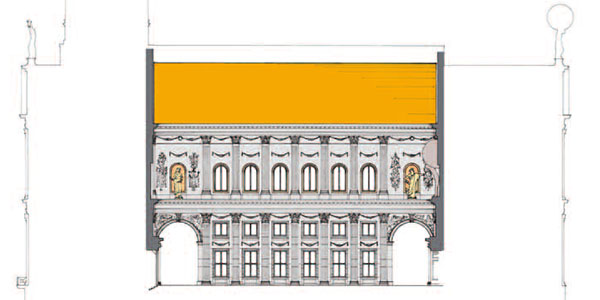Zandsteen als architectonische expressie. Bouwhistorisch onderzoek in het Koninklijk Paleis
DOI:
https://doi.org/10.7480/knob.112.2013.2.619##submission.downloads##

Samenvatting
In de afgelopen jaren (2006-2011) werd het voormalige stadhuis van Amsterdam, dat sinds 1808 in gebruik is als Koninklijk Paleis, gerestaureerd. Tijdens deze restauratiewerkzaamheden is zowel een bouwhistorisch als een kleurhistorisch onderzoek uitgevoerd. Het onderzoek heeft belangrijke informatie over de oorspronkelijke kleurstelling van het interieur opgeleverd, waarbij is komen vast te staan dat zandsteen(kleur) een belangrijke component van de architectonische expressie vormde.
De uitstraling van het huidige interieur van het Koninklijk Paleis wordt thans bepaald door een vroeg negentiende-eeuwse verbouwing en een aantal restauraties in de twintigste eeuw. Hierdoor is vooral op de bel-etage de oorspronkelijke zandsteen (kleur)afwerking vrijwel verdwenen. Op de begane grond is daarentegen de toepassing van zandsteen als onderdeel van de oorspronkelijke afwerking grotendeels behouden gebleven. De nu deels witgeschilderde zandsteen was oorspronkelijk onbeschilderd zoals blijkt uit de afwerking met een zeer fijne frijnslag.
Het onderzoek heeft ook uitgewezen dat de bel-etageruimten zoals de Oudraadzaal, Mozeszaal, Schepenkamer en de voormalige secretarie zijn voorzien van bakstenen gewelven met oorspronkelijk een zandsteenkleurige afwerking. Tevens is geconstateerd dat de in massief zandsteen uitgevoerde gewelven van de galerijen oorspronkelijk ook onbeschilderd waren. Deze oorspronkelijke kleurstelling vormt een contrast met de huidige witte uitstraling van de gewelven op de bel-etage.
In de Rekenkamer is de oorspronkelijke interieurafwerking het best behouden gebleven. Deze ruimte heeft geen overwelving, maar wordt afgedekt door een eikenhouten cassettenplafond. De blond bruine kleurstelling van dit plafond sluit harmonisch aan op de geel grijze zandstenen interieuronderdelen. Opmerkelijk is dat deze lichte kleurstelling van het plafond afwijkt van de overige cassettenplafonds op de bel-etage. Onderzoek wees uit dat de donkerder kleurstelling van de overige cassetteplafonds het gevolg is van een restauratie-interpretatie uit de twintigste eeuw. De primaire blond bruine kleur van de cassettenplafonds vormde oorspronkelijk ook een harmonieus evenwicht met de zandsteen(kleurige) gewelven in de overige bel-etageruimten.
Doordat het stadhuis in het begin van de negentiende eeuw werd verbouwd tot Koninklijk Paleis, gevolgd door een aantal restauraties tijdens de twintigste eeuw, is de oorspronkelijke kleurstelling van het interieur vrijwel verdwenen, waardoor de kennis hierover in de vergetelheid was geraakt.
Referenties
De voordracht van K. van den Ende over het kleuronderzoek in het Paleis op de Dam ter gelegenheid van het emeritaat van A. van Grevenstein vormde de aanleiding tot het schrijven van dit artikel.
Het kleurhistorisch onderzoek werd uitgevoerd door de Stichting Restauratieatelier Limburg (SRAL) en het bouwhistorisch onderzoek door de auteur.
N.H. van der Woude, Samenvatting stand van zaken kleurhistorisch onderzoek KPA, rapport, Amsterdam 2007. H.F.G. Hundertmark, ’t achtste wonderstuk. De bouwgeschiedenis van het stadhuis van Amsterdam, rapport, Oss 2012.
Op de begane grond bevinden zich in het totaal twaalf voormalige cellen (ook wel boeien genaamd), waarin verdachten werden ondergebracht. De vier vroegere gijzelkamers waren bestemd voor personen in schoutsgijzeling of civiele gijzeling.
Jacob van Campen had voor het ontwerp van de vierschaar twee varianten gemaakt. Bij het eerste variant is er sprake van een onbeschilderd tongewelf, bij de tweede is het gewelf voorzien van een rijke beschildering. Uiteindelijk werd gekozen voor een in massief Avender steen uitgevoerd tongewelf. Dat het inderdaad Avender steen betrof, wordt vermeld in: O. Dapper, Historische beschryving der stadt Amsterdam, Amsterdam 1663, 347.
M. van Eikema Hommes en E. Froment, ‘Het decoratie-programma in de galerijen van het Koninklijk Paleis Amsterdam: een harmonieuze interactie tussen schilderkunst, architectuur en licht?’, in: M. van der Zwaag, Opstand als opdracht. Flinck, Ovens, Lievens, Jordaens, De Groot, Bol en Rembrandt in het paleis, Amsterdam 2011, 34-53. Hundertmark 2012 (noot 2), 130-136.
Van Eikema Hommes en Froment 2011 (noot 5), 48.
Van Eikema Hommes en Froment 2011 (noot 5), 48.
Van Eikema Hommes en Froment 2011 (noot 5), 50.
Van Eikema Hommes en Froment 2011 (noot 5), 50.
P. Vlaardingerbroek, Het paleis van de Republiek. Geschiedenis van het stadhuis van Amsterdam, Zwolle 2011, 158.
Hundertmark 2012 (noot 2), 124-129.
Gepubliceerd
Citeerhulp
Nummer
Sectie
Artikelen
Licentie
Copyright (c) 2013 Hein Hundertmark

Dit werk wordt verdeeld onder een Naamsvermelding 4.0 Internationaal licentie.





